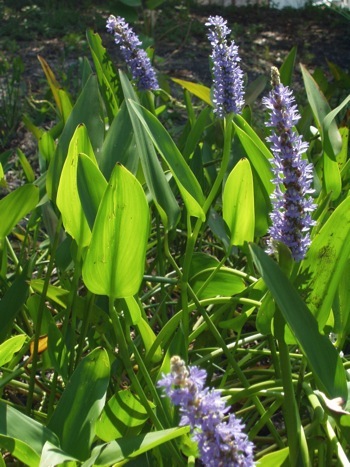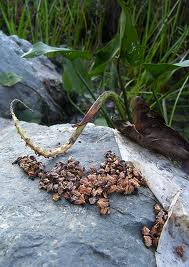Pontederia cordata: In a PR Pickerel
Pickerel Weed Primer
If the Pickerelweed could commiserate, it would find a friend with the Natal Plum. The Natal Plum has a deadly relative, the Oleander, which gets all the attention. The Pickerelweed’s close cousin, the Water Hyacinth, is arguably the most despised and expensive weed in the world. While damning the hyacinth few praise the Pickerelweed.
It’s found in eastern North America then down to Argentina. Also in Oregon and as an ornamental in Europe and elsewhere. It’s given short shift in many foraging books. Its seeds, however, are nutritious and can be eaten raw or cooked. They can be boiled like rice or roasted. Parched for a few minutes they are excellent. When dried they make a good grain for bread. Its young unfurled leaves can be eaten raw or boiled for about 10 minutes. Stalks are edible as well.
Two advantages of the Pickerelweed is that if it comes from wholesome water the leaves and seeds need no cooking. In fact where I live it is about the only source of starch that does not need to be cooked.
Deer are particularly fond of Pickerelweed, as are muskrats and pickerels in more northern climes. It’s been around long enough to have its own bee for pollination, the Dufourea novae-angliae, which visits this plant for nectar and pollen and does not visit any other plant. Several ducks also eat the seeds including Mallard, Black Duck, Green-Winged Teal, and Wood Duck.
Cordata means heart-shaped and Pontederia honors Italian physician Guilio Pontedera, who also kept the Botanical Gardens at Padua for 38 years. The name is said pon-tee-DEER-ree-uh kor-DAY-tuh.
Green Deane’s “Itemized” Plant Profile
IDENTIFICATION: Large plant to four feet, produces one spike of small lavender stalkless flowers, 50 to 100 of them. Long, heart-shaped leaves, or arrow shaped or lance shaped. The flower stem rises above the leaves except one leaf reaches up and grows behind the flower. Veins of leaf are parallel, J-curved, never with net-like veins between them.
TIME OF YEAR: Blossoms in summer seeds in fall, however in Florida it can bloom from March to November.
ENVIRONMENT: It likes shallow water, a foot deep or so, either the edge of a slow moving stream, or ponds and lakes.
METHOD OF PREPARATION: Seeds, raw or cooked, parched, boiled or roasted, best collected when they fall into your hand off the plant. They make a good flour. I like to lightly roast them and take them on the trail with me. Young unfurled leaves and stalks boiled.





I think some of the common nicknames for freshwater pickerelweed are Tuckahoe, black potato, Wampee, and Wampi. The latter two common names sound like Indian derivatives.
I think you are mixing up some other plants. Pickerel Weed does not have an edible root or corm.
You might be referencing the cattail plant. Young cattail shoots and roots are also edible parts of cattail plants.
Up here in Northern MN the pickerel weed is being managed like an invasive species as it crowds out wild rice beds. Local resource agencies are considering raising water levels & decreasing management of beaver populations in these lakes to try & combat the pickerel weed.
Hi, are there any down sides to Pickerel? Like the itch of Water Hyacinth? I am doing a small scale (pun intended) fish farming experiment and would like to either eat the extra Pickerel myself or feed it to my rabbits, ducks, chickens or pigs.
We have it all over my yard. Haven’t tried growing in our koi pond but I would imagine they would eat it up faster thank it grows lol but start out with a decent amount because they do grown fast and they are beautiful when they flower. We eat the young leaves and my chickens, goats, and pigs love it. But mostly, my ducks go crazy 🙂
Is Pontederia cordata ok for cows? I was thinking of putting it in a pond that my cattle drink from.
Write more, thats all I have to say. Literally, it seems as though you relied on the video to make your point. You definitely know what youre talking about, why waste your intelligence on just posting videos to your blog when you could be giving us something enlightening to read?
You lying spammer. There are over 1,000 articles to read, NOT ONE VIDEO HERE.